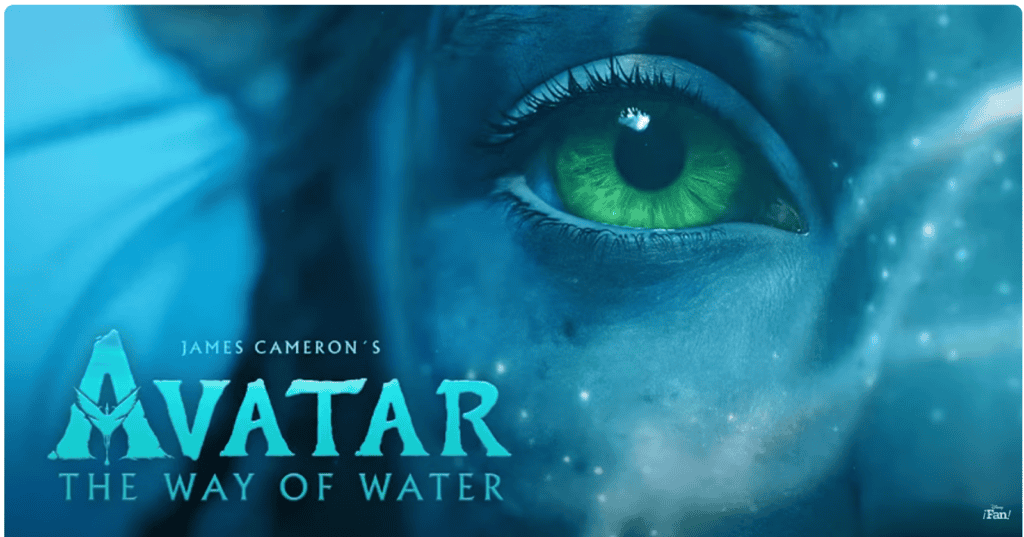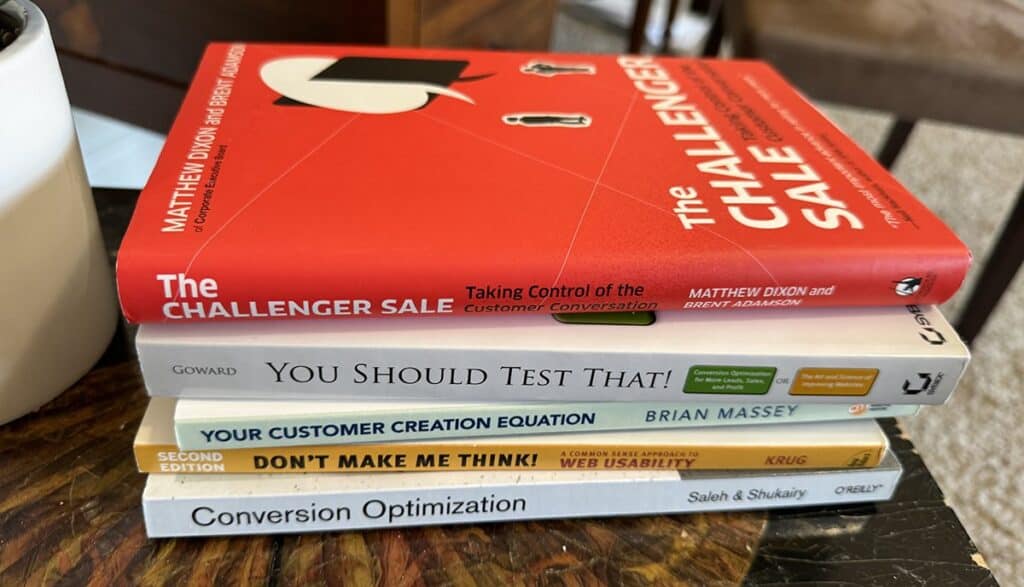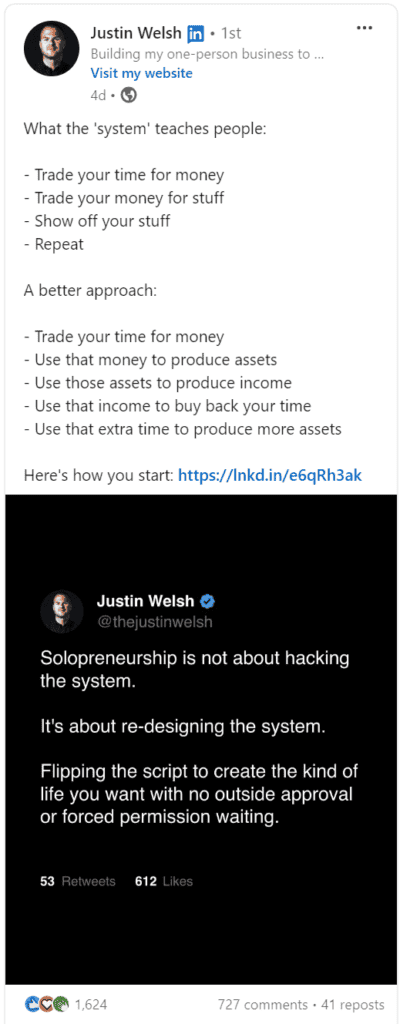We talk a lot about quality content. But what exactly does that mean? What qualifies as “good content”? How does the quality of the content on your website impact growth?
In this article, I share my Blockbuster Approach to quality content, along with 13 checkpoints to ensure you produce quality content that drives authority, trust, and revenue.
What Is Quality Content?
Quality content is content that benefits both your audience and your business. For your audience, it answers questions, demonstrates your expertise and authority, and turns casual visitors into fans and customers. For your business, it attracts your ideal customers, builds their trust, and helps accelerate revenue growth.
Like a blockbuster movie, good content exceeds expectations. It surprises and delights. It engages people on multiple levels. And it holds your audience’s attention to the very end.
Interestingly, we recognize quality content in entertainment. A blockbuster movie has A-list actors and higher production quality. Think Avatar.

A B-film has a lower budget, tighter shooting schedules, and formulaic scripts. Think Sharknado, a fun film but a far cry from award-winning films.

You can see a similar distinction in business content. Red Bull creates content that’s higher quality than many movies. They describe it as “breathtaking video and stills” and “exclusive interviews and news.”
By contrast, many brands create generic content written by inexperienced writers or AI simply to meet a production schedule. There’s nothing breathtaking about it. And for most readers, no reason to consume it.
Good content gives a good return on the investment of time, both yours to create it and your customers to read it.
Why Does Quality Content Matter?
Creating high-quality content takes time and effort. When you’re facing hard deadlines, it’s easy to focus on getting projects out the door without worrying about quality. Here’s why it’s worth your time to maintain the highest content quality:
- Quality is a differentiator.
- It can impact SEO and AIO.
- It can boost social engagement.
- It keeps your customers engaged at every stage of their journey.
#1: Quality is a differentiator
Your content is people’s first impression of your brand. Your topics tell your audience what your business is about. The quality of your content tells them how much you care.
It also gives them a taste of the customer experience you’ll provide after they make a purchase.
Poorly written or produced content makes people think you aren’t capable of high-quality work or that you don’t know the difference. Either way, it lowers trust and makes them less likely to choose your product.
From their perspective, if your public-facing content is low quality, your product itself may also be low quality.
Content quality can raise or lower your value in the marketplace. That makes it a key differentiator.
#2: Quality can impact SEO and AIO
Whether optimizing for Google or generative AI, one of the highest ranking factors in SEO is quality. Google’s EEAT criteria is a clear signal that quality content is important.
Quality content for SEO demonstrates:
- Experience
- Expertise
- Authority
- Trustworthiness
Microsoft Bing is no different. If they consistently put low-quality content at the top of search engine results pages (SERPs), people will turn to a different search engine. Search engines want high-quality content that can help users find the best answers to their queries.
On a side note, EEAT is simply good marketing. By using EEAT as a criterion for all your content, you’ll not only improve your SEO, you’ll also drive more conversions.
#3: Quality can improve social engagement
Social media algorithms are also evaluating the quality of your content. Social platforms want users to stay on the platform as long as possible. That’s only possible if creators publish high-quality content that’s fun to engage with. If you can create content that helps them reach their goals, they’ll reward you with higher visibility.
For example, LinkedIn is known to throttle content that doesn’t meet their quality standards. But for users who regularly publish valuable content, sharing tips that resonate with their audience, they accelerate reach.
#4: Content keeps your customers engaged at every stage of their journey
Content is a key growth strategy for business. Whether your content is paid or organic, it puts your product in front of your best prospects and tells them why it’s worth their consideration.
But your content should align with the customer journey, providing answers and insights at each stage of their buying journey.
It should attract your ideal customers and help them make a better buying decision. Then, after their purchase, it should keep them engaged with your brand for the long term, driving retention and raising their lifetime value.
How to Create Quality Content: 13 Characteristics
When you’re creating text, video, or audio content, you need to meet basic quality standards. Here are the characteristics that mark high-quality, high-value content that gets blockbuster reviews.
1. Quality content has a purpose.
One of my biggest beefs is content for content’s sake. If you don’t have anything to say, you don’t need to hit the publish button.
Every piece of content should have a bottom-line takeaway that matters to your audience. Its value proposition should be clear, and your content should deliver on that promise.
Interestingly, the purpose of a piece of content can be quite simple. You don’t have to rock the world. Just offer value:
- Introduce a new concept or idea.
- Share practical tips.
- Give step-by-step instructions on how to do something.
- Create a list of resources or tools.
- Compare your product to alternatives — with pros and cons for each.
- Tell prospects how to choose the right solution for their needs.
2. Quality content helps you achieve your business goals.
Not only should every piece of content have a purpose, it needs to help you drive growth.
- Top-of-funnel content should drive awareness and attract your best customers.
- Middle-of-funnel content should build relationships and educate prospects about your solutions.
- Bottom-of-funnel content should drive sales and shorten the sales process.
- Below-the-funnel content should promote adoption, retention, and customer lifetime value.
How valuable is your blog content? Use the Content Value Calculator.
3. It’s relevant to your audience.
Quality content is designed to attract qualified buyers. It speaks directly to them, answering their questions and giving them useful tips and tricks.
Too often, brands create content for their own benefit: traffic, sales, etc. (See #2 above.) Quality content can strike a balance between serving the organization and the audience.
SEO content is a good example of this. The content strategist will select keywords to attract the right traffic. But because the content’s purpose is traffic, it’s written more for search bots than humans. The result is often lower quality content that adds no value to your audience.
Quality content is design for your audience. It’s relevant to them. It aims to add value to them.
4. Quality content is original.
A little-known secret: Before ChatGPT entered the scene, when content creators were given an assignment, they started by searching the article’s keyword to see what other brands had written on the same topic. They took the ideas and tips from those articles, added their own flavoring, and created a “new” piece of content. Today, they ask their favorite AI writing tool to create the outline and then draft some or all of the content.
Neither of these strategies can deliver original content that achieves your business goals. Content should convey your proprietary ideas and messaging, expressed in your brand’s voice. It should build your authority and trust with ideal customers.
Don’t copy. Don’t imitate. Don’t enter the echo chamber.
Tap into the intelligence within your organization to create quality content that couldn’t be created by anyone else:
- Your brand message or point of view
- Your proprietary solutions and methods
- Original research
- Ideas that differentiate you from your competitors
Learn more about building an Authority Ecosystem for your brand in this article.
5. Quality content shares meaningful information.
Junk content gets junk results. If you want traffic, conversions, and growth, your content can’t be poorly written or shallow.
Don’t withhold valuable information because it’s “above your audience’s pay grade.” Be generous. Visitors have told me that my content rivals anything they’ve seen in a paid course or program, and they were impressed that I gave it away for free. But I never had to advertise my services because my content did the selling for me.
Alex Hormozi has the same philosophy. His book $100M Offers shares everything he knows about building great offers. He doesn’t work with small businesses, so he wrote this book for them. His goal is to help more businesses achieve $10 million in annual revenue so they can afford to hire him.
Meaningful content can’t be created by scraping other websites’ ideas or letting AI write for you. You need to share your expertise and help your audience succeed.
Bottom line: Create something that’s worth your audience’s time and attention. And make sure they walk away better for having consumed it.
6. All claims are proved.
Op-eds aside, the best content doesn’t just contain opinions. It creates a logical argument for or against something — and every point is backed up by statistics, quotes, examples, and stories.
This requires research. Real research, not just scraping other people’s ideas. For example, when I was hired to run the Crazy Egg blog, I learned everything I could about conversion rate optimization. I connected with experts and read every book I could find. Even now, this stack of books sits on the table beside my work station.

This research helped me become a subject matter expert (or close) and gave me sources for quotes from industry experts. But books aren’t your only resource. You can also tap into other authoritative sources:
- Industry reports
- Scholarly articles
- Recognized new sites
- Expert presentations and speeches
- Interviews with internal subject matter experts
- Interviews with industry experts
Good research increases the trustworthiness of your content. If you already have recognized expertise in your topic, it validates your points. If you don’t, it gives you borrowed authority.
Which brings me to another point. Your claims need to be accurate. Don’t write a U.S. Independence Day post with a reference to Benjamin Franklin as a former president. (Yes, I’ve had a writer do that. No, I don’t work with that writer anymore.)
Don’t guess. Don’t make things up. Fact-check everything — especially if you use AI to help you draft your content.
Related: What Your Editor Wishes You Knew About Writing Better Blog Posts
7. Quality content provides context and analysis.
Let’s take #6 a little further. Content creation isn’t just about sharing a point of view and a few statistics. It’s about giving people context — how and why your point matters — and analysis to clarify and interpret the information you’re sharing.
By the way, this becomes exponentially more important when you’re writing about topics that are complex or topics that are adjacent or loosely connected to your primary message.
Don’t assume your readers will make the connections that seem obvious to you. Connect the dots for them. Most people are too busy to spend more than a few minutes on your content, so it needs to be easy to read, easy to understand, and easy to apply.
Which brings me to another point…
8. Quality content is clear.
In high-quality content, information is presented in an organized way and articulated clearly. That makes it a breeze to read. Which brings up an important topic: readability.
If you’ll allow me, I’m going to nerd out on readability for a moment.
Readability is essential if you want to communicate. While it’s important to written content, it also applies to visual content. Here’s why:
People need to be able to grasp your message at first glance.
But this level of clarity depends on your audience. If you’re writing for conversion experts, you’ll talk about statistical relevance and deltas and other complicated concepts. For a less educated audience, you’ll talk about the need to use data to make decisions about your site’s content.
Readability demands that you never talk above or below your target audience. If your content is over their heads, they’ll become confused and look for content that’s more accessible. If you talk below them, they’ll question your ability to serve their needs.
Clarity means your content is easy for your audience to understand. You speak their language. You use the same terminology they use. You share illustrations and examples that are relevant to them.
9. Quality content is well written/produced.
My father used to say, If it’s worth doing, it’s worth doing right, and he’s right. If you like an idea enough to add it to your editorial calendar, it’s worth the time it takes to do it right. That means great writing, great video or sound quality, and great production.
The basics of good writing apply here:
- Structure your message logically.
- Introduce your main point in the introduction.
- Use simple sentence structures.
- Number long lists or use bullet points to make each item clearly visible.
- Use proper grammar.
- Avoid wordiness and fluff.
Your writing should never draw attention to itself. Bad writing takes the focus off your message and puts it on your words. You want your writing to disappear behind the message.
The best content is created in layers. It progresses through stages of development, from idea to outline to draft to your polished final production. In each iteration, the project is refined and improved until it’s worth your audience’s attention.
10. Quality content is optimized for results.
Content should be optimized for three things:
- Humans
- Search
- Conversions
Optimizing for humans is about making sure your audience consumes the content. It should be readable and accessible to everyone, including people with digital disabilities. For example, videos should have captions, and images should have appropriate alt tags. It’s also important to explain any technical terms people may be unfamiliar with.
Optimizing for search is about making sure your content could rank well in search results. As I mentioned above, content should be created for humans first and SEO second. Otherwise, the content could end up missing the mark for your target audience.
That said, I generally try to find an appropriate keyword for every piece of content I produce. The keyword can have any search volume. Low-volume keywords are often easier to rank for, making them a good place to start with search engine optimization.
Depending on the industry, high-volume keywords can be almost impossible to rank for. But don’t let that deter you. A well-written, authoritative guide that’s optimized for a top-level keyword can still add value to your site. It signals to search engines that you’re an expert in the topic, which improves your ability to rank for related terms. And it becomes a sharable asset that can attract potential customers.
Finally, optimizing for conversions is about making sure your audience is eager to take their next step with you, whether that’s subscribing, scheduling a call, or making a purchase.
Treat every page as a landing page, and you’ll nail this one.
11. Quality content is visually appealing.
I’m not talking about graphics here, though they can help you create a better user experience. I’m talking about white space, layout, images, and other design elements.
Make sure the overall page is as attractive as the ideas you’re sharing. You’re going for a Wow! response. That means all the elements need to be right.
An attractive page can help you keep people on the page longer. And again, this is easier than you think.
If you leverage design principles properly, you can also improve your ability to drive action. Here, I’m talking about white space, color, and layout. Used properly, they can help you lead people to your call to action, making it easier to achieve your goals for that piece of content.
On a side note, an eye for design can also help your social media posts. For instance:
- Add extra returns to create sections within a long-form post.
- Use emojis as bullets or to highlight an important point.
- Use a lot of one-liners.
Justin Welsh likes to create cascading bullet lists:

Related: Social Media Best Practices for Growth & Engagement
12. Quality content provides an experience.
Perhaps the best way to summarize this point is this: The presentation and experience are as good as the content itself.
Don’t limit yourself to one format or type of content. Create a multimedia experience for your visitors. Create content that lives on your website and pieces that can be taken home, such as books and PDFs. Create text and visual content. And connect everything with an internal linking strategy that takes people on an exploratory journey through your website.
13. Quality content is up to date.
Content can easily lose relevance if it becomes outdated. Early content strategists leveraged evergreen content to maintain relevance long-term, but even evergreen content can become outdated.
Let’s review the basics: A good content strategy includes both evergreen and timely content.
- Evergreen content can withstand the test of time. It remains valuable for months, if not years. This article is a good example. I wrote it originally in 2015, and it only recently became outdated.
- Timely content has a short lifespan. It is relevant now and can quickly become outdated. A good example is a product update article.
Most websites today, especially if they’ve been doing content marketing since the early days of business blogging, will have outdated content — both evergreen and timely content. This rarely creates problems since search engines stop ranking outdated content. But it is an opportunity.
If your website has a lot of outdated content, you may find more value in updating old content than creating new content. Adapt your strategy to include content updates as well as new content.
When you update existing content, make it better by improving the messaging, writing quality, and media. Update statistics and add new research or talking points. Then give it a new publish date and promote it as you would new content.
It’s important to regularly review your content to identify pieces that are outdated but still valuable. Articles that include years (e.g., best growth strategies in 2024) need to be updated annually. Other articles may have a longer review cycle.
If an old article is worth updating, do so. But never hesitate to delete or unpublish content that no longer adds value to your audience.
Quality Matters
Generating high-quality content may take effort, but it’s worth the investment. Make your content more valuable, and it will:
- Drive more traffic
- Improve your customer experience
- Increase acquistion and retention
- Turn casual users into superfans
- Make you your customers’ go-to resource
If you’re struggling to create quality content that drives real results, I can help. My strategies drive product awareness, sales, and bottom-line revenue. Let’s talk.


